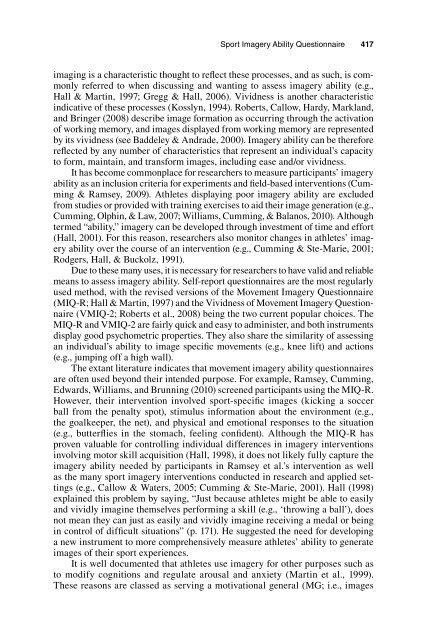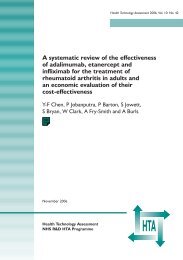Measuring Athlete Imagery Ability: The Sport ... - ResearchGate
Measuring Athlete Imagery Ability: The Sport ... - ResearchGate
Measuring Athlete Imagery Ability: The Sport ... - ResearchGate
You also want an ePaper? Increase the reach of your titles
YUMPU automatically turns print PDFs into web optimized ePapers that Google loves.
<strong>Sport</strong> <strong>Imagery</strong> <strong>Ability</strong> Questionnaire 417<br />
imaging is a characteristic thought to reflect these processes, and as such, is commonly<br />
referred to when discussing and wanting to assess imagery ability (e.g.,<br />
Hall & Martin, 1997; Gregg & Hall, 2006). Vividness is another characteristic<br />
indicative of these processes (Kosslyn, 1994). Roberts, Callow, Hardy, Markland,<br />
and Bringer (2008) describe image formation as occurring through the activation<br />
of working memory, and images displayed from working memory are represented<br />
by its vividness (see Baddeley & Andrade, 2000). <strong>Imagery</strong> ability can be therefore<br />
reflected by any number of characteristics that represent an individual’s capacity<br />
to form, maintain, and transform images, including ease and/or vividness.<br />
It has become commonplace for researchers to measure participants’ imagery<br />
ability as an inclusion criteria for experiments and field-based interventions (Cumming<br />
& Ramsey, 2009). <strong>Athlete</strong>s displaying poor imagery ability are excluded<br />
from studies or provided with training exercises to aid their image generation (e.g.,<br />
Cumming, Olphin, & Law, 2007; Williams, Cumming, & Balanos, 2010). Although<br />
termed “ability,” imagery can be developed through investment of time and effort<br />
(Hall, 2001). For this reason, researchers also monitor changes in athletes’ imagery<br />
ability over the course of an intervention (e.g., Cumming & Ste-Marie, 2001;<br />
Rodgers, Hall, & Buckolz, 1991).<br />
Due to these many uses, it is necessary for researchers to have valid and reliable<br />
means to assess imagery ability. Self-report questionnaires are the most regularly<br />
used method, with the revised versions of the Movement <strong>Imagery</strong> Questionnaire<br />
(MIQ-R; Hall & Martin, 1997) and the Vividness of Movement <strong>Imagery</strong> Questionnaire<br />
(VMIQ-2; Roberts et al., 2008) being the two current popular choices. <strong>The</strong><br />
MIQ-R and VMIQ-2 are fairly quick and easy to administer, and both instruments<br />
display good psychometric properties. <strong>The</strong>y also share the similarity of assessing<br />
an individual’s ability to image specific movements (e.g., knee lift) and actions<br />
(e.g., jumping off a high wall).<br />
<strong>The</strong> extant literature indicates that movement imagery ability questionnaires<br />
are often used beyond their intended purpose. For example, Ramsey, Cumming,<br />
Edwards, Williams, and Brunning (2010) screened participants using the MIQ-R.<br />
However, their intervention involved sport-specific images (kicking a soccer<br />
ball from the penalty spot), stimulus information about the environment (e.g.,<br />
the goalkeeper, the net), and physical and emotional responses to the situation<br />
(e.g., butterflies in the stomach, feeling confident). Although the MIQ-R has<br />
proven valuable for controlling individual differences in imagery interventions<br />
involving motor skill acquisition (Hall, 1998), it does not likely fully capture the<br />
imagery ability needed by participants in Ramsey et al.’s intervention as well<br />
as the many sport imagery interventions conducted in research and applied settings<br />
(e.g., Callow & Waters, 2005; Cumming & Ste-Marie, 2001). Hall (1998)<br />
explained this problem by saying, “Just because athletes might be able to easily<br />
and vividly imagine themselves performing a skill (e.g., ‘throwing a ball’), does<br />
not mean they can just as easily and vividly imagine receiving a medal or being<br />
in control of difficult situations” (p. 171). He suggested the need for developing<br />
a new instrument to more comprehensively measure athletes’ ability to generate<br />
images of their sport experiences.<br />
It is well documented that athletes use imagery for other purposes such as<br />
to modify cognitions and regulate arousal and anxiety (Martin et al., 1999).<br />
<strong>The</strong>se reasons are classed as serving a motivational general (MG; i.e., images
















